Wireless Networking Report: Antenna, Multiplexing Techniques Analysis
VerifiedAdded on 2020/03/07
|6
|967
|238
Report
AI Summary
This report provides an overview of wireless networking, focusing on antenna technologies and multiplexing techniques. It begins by describing different types of antennas, including horn, Yagi, and cellular antennas, highlighting their advantages and disadvantages. The report then delves into multiplexing techniques, specifically comparing and contrasting Code Division Multiple Access (CDMA) and Frequency Division Multiple Access (FDMA). It examines the key differences between these techniques in terms of how they share bandwidth, handle interference, and manage power efficiency, providing a comprehensive analysis of their performance characteristics. The report concludes by emphasizing the importance of smart antennas in the future of wireless communication.
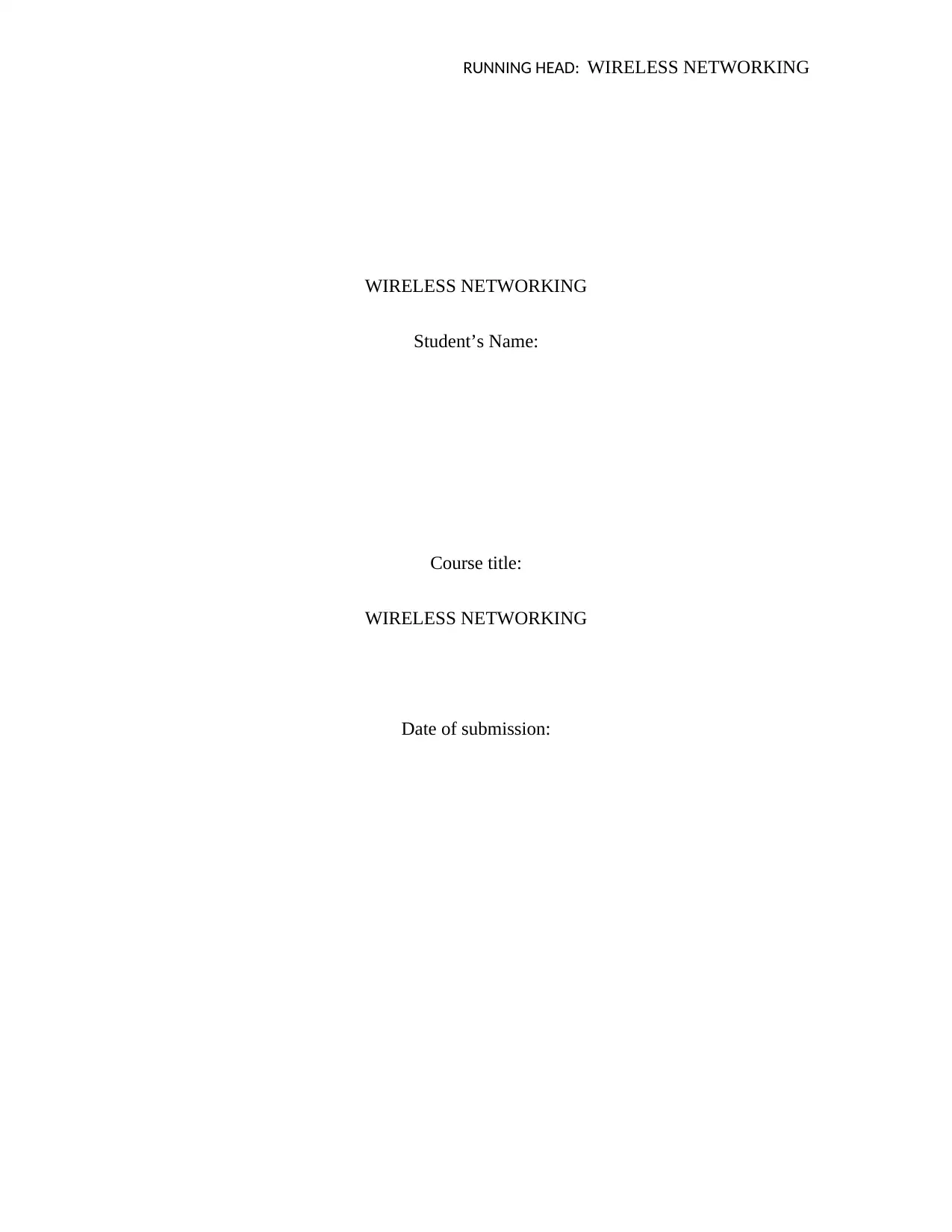
RUNNING HEAD: WIRELESS NETWORKING
WIRELESS NETWORKING
Student’s Name:
Course title:
WIRELESS NETWORKING
Date of submission:
WIRELESS NETWORKING
Student’s Name:
Course title:
WIRELESS NETWORKING
Date of submission:
Paraphrase This Document
Need a fresh take? Get an instant paraphrase of this document with our AI Paraphraser
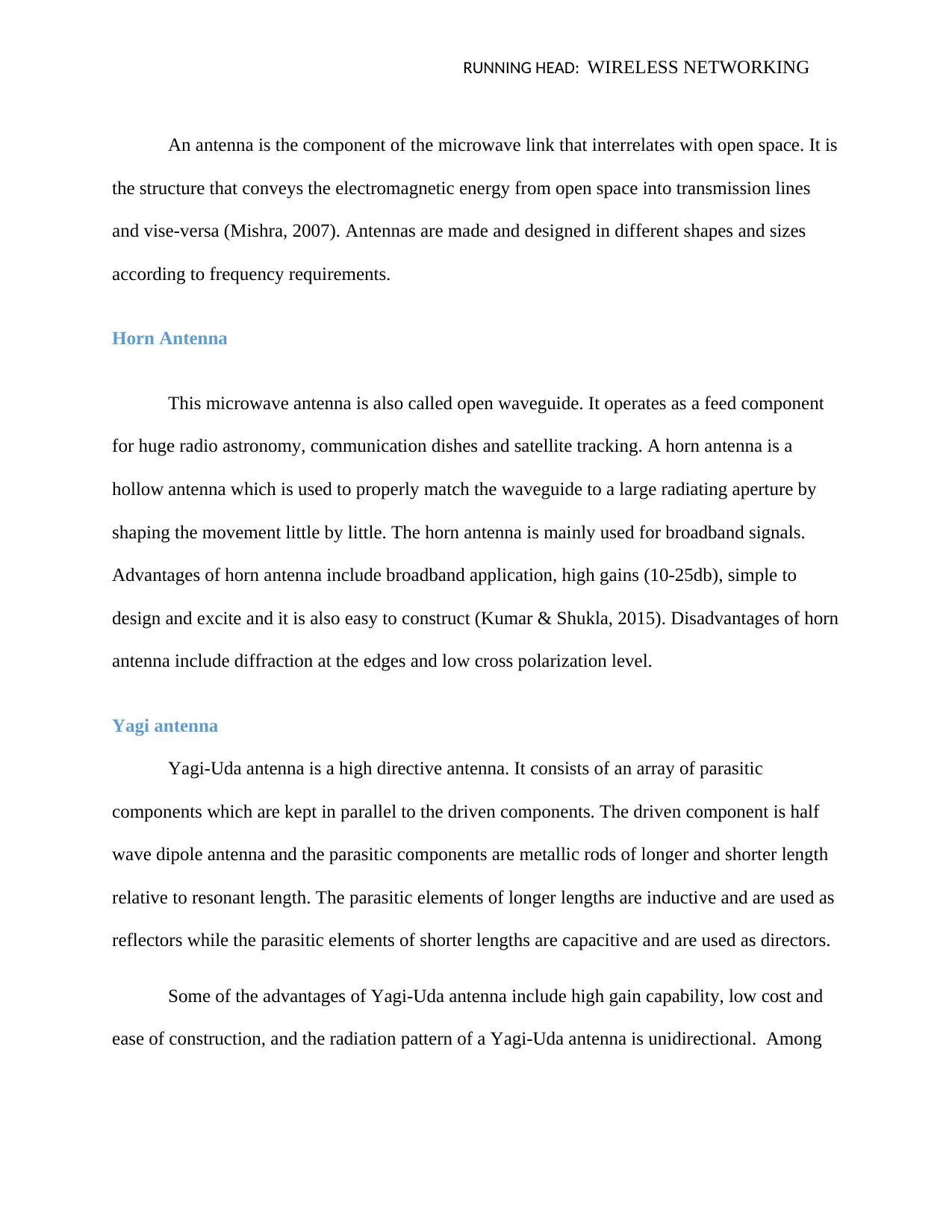
RUNNING HEAD: WIRELESS NETWORKING
An antenna is the component of the microwave link that interrelates with open space. It is
the structure that conveys the electromagnetic energy from open space into transmission lines
and vise-versa (Mishra, 2007). Antennas are made and designed in different shapes and sizes
according to frequency requirements.
Horn Antenna
This microwave antenna is also called open waveguide. It operates as a feed component
for huge radio astronomy, communication dishes and satellite tracking. A horn antenna is a
hollow antenna which is used to properly match the waveguide to a large radiating aperture by
shaping the movement little by little. The horn antenna is mainly used for broadband signals.
Advantages of horn antenna include broadband application, high gains (10-25db), simple to
design and excite and it is also easy to construct (Kumar & Shukla, 2015). Disadvantages of horn
antenna include diffraction at the edges and low cross polarization level.
Yagi antenna
Yagi-Uda antenna is a high directive antenna. It consists of an array of parasitic
components which are kept in parallel to the driven components. The driven component is half
wave dipole antenna and the parasitic components are metallic rods of longer and shorter length
relative to resonant length. The parasitic elements of longer lengths are inductive and are used as
reflectors while the parasitic elements of shorter lengths are capacitive and are used as directors.
Some of the advantages of Yagi-Uda antenna include high gain capability, low cost and
ease of construction, and the radiation pattern of a Yagi-Uda antenna is unidirectional. Among
An antenna is the component of the microwave link that interrelates with open space. It is
the structure that conveys the electromagnetic energy from open space into transmission lines
and vise-versa (Mishra, 2007). Antennas are made and designed in different shapes and sizes
according to frequency requirements.
Horn Antenna
This microwave antenna is also called open waveguide. It operates as a feed component
for huge radio astronomy, communication dishes and satellite tracking. A horn antenna is a
hollow antenna which is used to properly match the waveguide to a large radiating aperture by
shaping the movement little by little. The horn antenna is mainly used for broadband signals.
Advantages of horn antenna include broadband application, high gains (10-25db), simple to
design and excite and it is also easy to construct (Kumar & Shukla, 2015). Disadvantages of horn
antenna include diffraction at the edges and low cross polarization level.
Yagi antenna
Yagi-Uda antenna is a high directive antenna. It consists of an array of parasitic
components which are kept in parallel to the driven components. The driven component is half
wave dipole antenna and the parasitic components are metallic rods of longer and shorter length
relative to resonant length. The parasitic elements of longer lengths are inductive and are used as
reflectors while the parasitic elements of shorter lengths are capacitive and are used as directors.
Some of the advantages of Yagi-Uda antenna include high gain capability, low cost and
ease of construction, and the radiation pattern of a Yagi-Uda antenna is unidirectional. Among
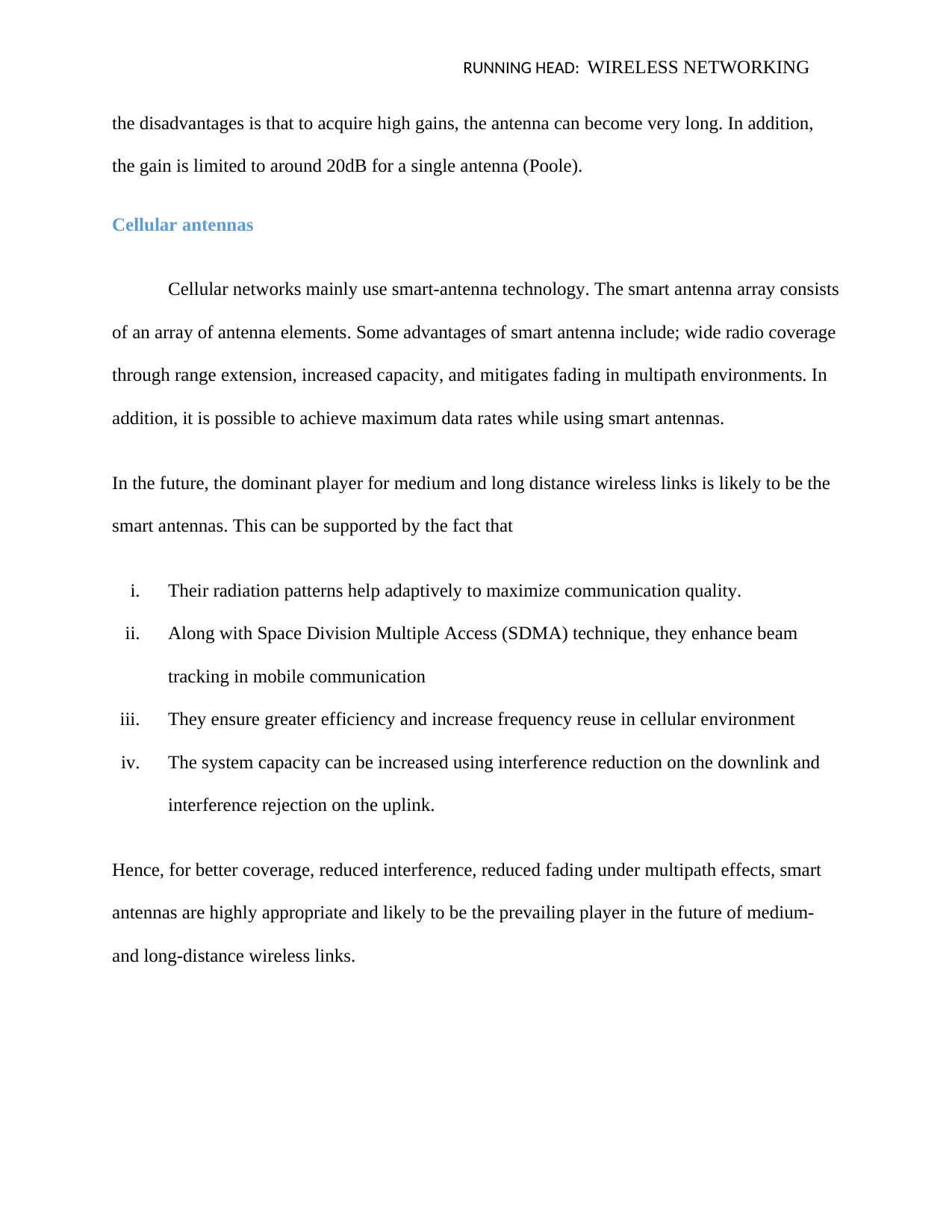
RUNNING HEAD: WIRELESS NETWORKING
the disadvantages is that to acquire high gains, the antenna can become very long. In addition,
the gain is limited to around 20dB for a single antenna (Poole).
Cellular antennas
Cellular networks mainly use smart-antenna technology. The smart antenna array consists
of an array of antenna elements. Some advantages of smart antenna include; wide radio coverage
through range extension, increased capacity, and mitigates fading in multipath environments. In
addition, it is possible to achieve maximum data rates while using smart antennas.
In the future, the dominant player for medium and long distance wireless links is likely to be the
smart antennas. This can be supported by the fact that
i. Their radiation patterns help adaptively to maximize communication quality.
ii. Along with Space Division Multiple Access (SDMA) technique, they enhance beam
tracking in mobile communication
iii. They ensure greater efficiency and increase frequency reuse in cellular environment
iv. The system capacity can be increased using interference reduction on the downlink and
interference rejection on the uplink.
Hence, for better coverage, reduced interference, reduced fading under multipath effects, smart
antennas are highly appropriate and likely to be the prevailing player in the future of medium-
and long-distance wireless links.
the disadvantages is that to acquire high gains, the antenna can become very long. In addition,
the gain is limited to around 20dB for a single antenna (Poole).
Cellular antennas
Cellular networks mainly use smart-antenna technology. The smart antenna array consists
of an array of antenna elements. Some advantages of smart antenna include; wide radio coverage
through range extension, increased capacity, and mitigates fading in multipath environments. In
addition, it is possible to achieve maximum data rates while using smart antennas.
In the future, the dominant player for medium and long distance wireless links is likely to be the
smart antennas. This can be supported by the fact that
i. Their radiation patterns help adaptively to maximize communication quality.
ii. Along with Space Division Multiple Access (SDMA) technique, they enhance beam
tracking in mobile communication
iii. They ensure greater efficiency and increase frequency reuse in cellular environment
iv. The system capacity can be increased using interference reduction on the downlink and
interference rejection on the uplink.
Hence, for better coverage, reduced interference, reduced fading under multipath effects, smart
antennas are highly appropriate and likely to be the prevailing player in the future of medium-
and long-distance wireless links.
⊘ This is a preview!⊘
Do you want full access?
Subscribe today to unlock all pages.

Trusted by 1+ million students worldwide
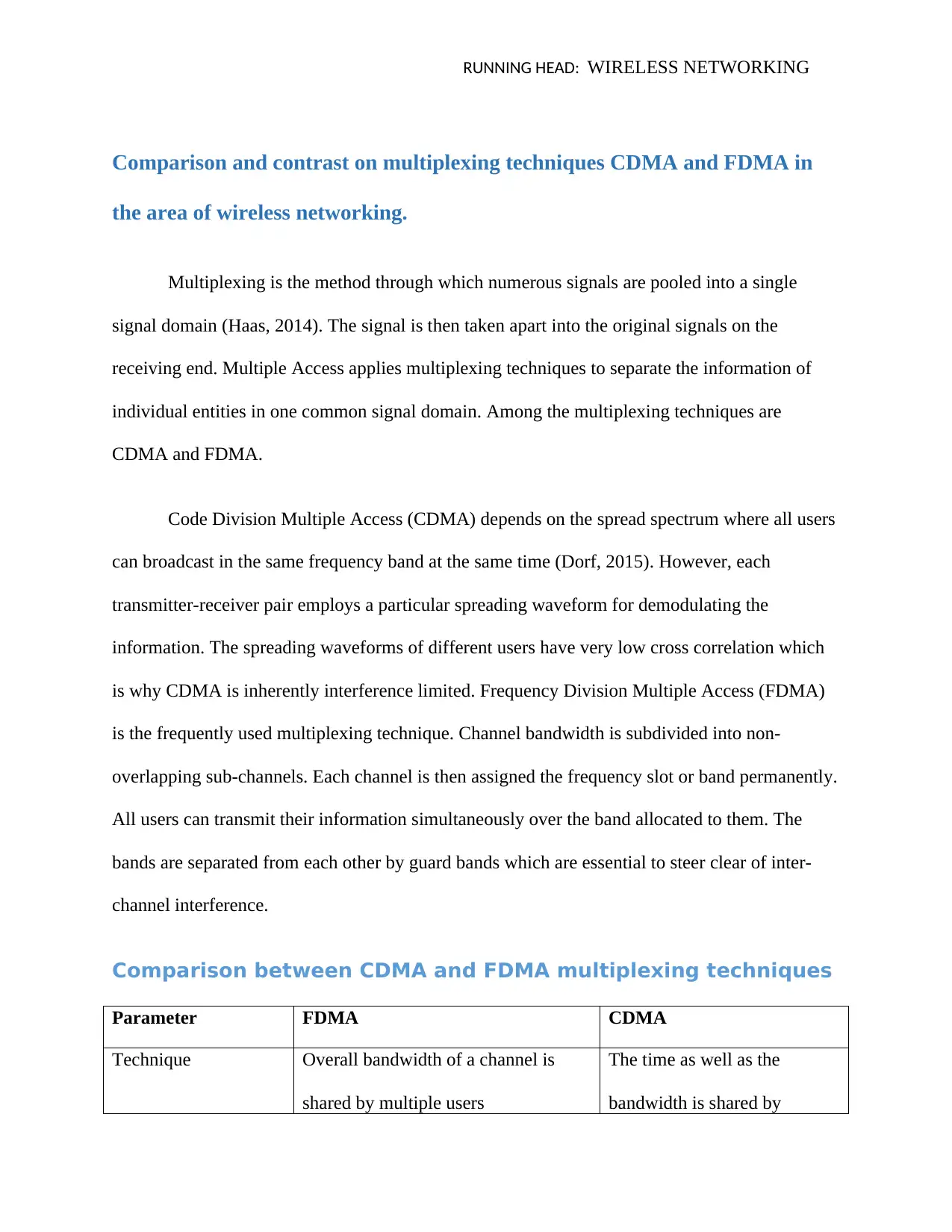
RUNNING HEAD: WIRELESS NETWORKING
Comparison and contrast on multiplexing techniques CDMA and FDMA in
the area of wireless networking.
Multiplexing is the method through which numerous signals are pooled into a single
signal domain (Haas, 2014). The signal is then taken apart into the original signals on the
receiving end. Multiple Access applies multiplexing techniques to separate the information of
individual entities in one common signal domain. Among the multiplexing techniques are
CDMA and FDMA.
Code Division Multiple Access (CDMA) depends on the spread spectrum where all users
can broadcast in the same frequency band at the same time (Dorf, 2015). However, each
transmitter-receiver pair employs a particular spreading waveform for demodulating the
information. The spreading waveforms of different users have very low cross correlation which
is why CDMA is inherently interference limited. Frequency Division Multiple Access (FDMA)
is the frequently used multiplexing technique. Channel bandwidth is subdivided into non-
overlapping sub-channels. Each channel is then assigned the frequency slot or band permanently.
All users can transmit their information simultaneously over the band allocated to them. The
bands are separated from each other by guard bands which are essential to steer clear of inter-
channel interference.
Comparison between CDMA and FDMA multiplexing techniques
Parameter FDMA CDMA
Technique Overall bandwidth of a channel is
shared by multiple users
The time as well as the
bandwidth is shared by
Comparison and contrast on multiplexing techniques CDMA and FDMA in
the area of wireless networking.
Multiplexing is the method through which numerous signals are pooled into a single
signal domain (Haas, 2014). The signal is then taken apart into the original signals on the
receiving end. Multiple Access applies multiplexing techniques to separate the information of
individual entities in one common signal domain. Among the multiplexing techniques are
CDMA and FDMA.
Code Division Multiple Access (CDMA) depends on the spread spectrum where all users
can broadcast in the same frequency band at the same time (Dorf, 2015). However, each
transmitter-receiver pair employs a particular spreading waveform for demodulating the
information. The spreading waveforms of different users have very low cross correlation which
is why CDMA is inherently interference limited. Frequency Division Multiple Access (FDMA)
is the frequently used multiplexing technique. Channel bandwidth is subdivided into non-
overlapping sub-channels. Each channel is then assigned the frequency slot or band permanently.
All users can transmit their information simultaneously over the band allocated to them. The
bands are separated from each other by guard bands which are essential to steer clear of inter-
channel interference.
Comparison between CDMA and FDMA multiplexing techniques
Parameter FDMA CDMA
Technique Overall bandwidth of a channel is
shared by multiple users
The time as well as the
bandwidth is shared by
Paraphrase This Document
Need a fresh take? Get an instant paraphrase of this document with our AI Paraphraser
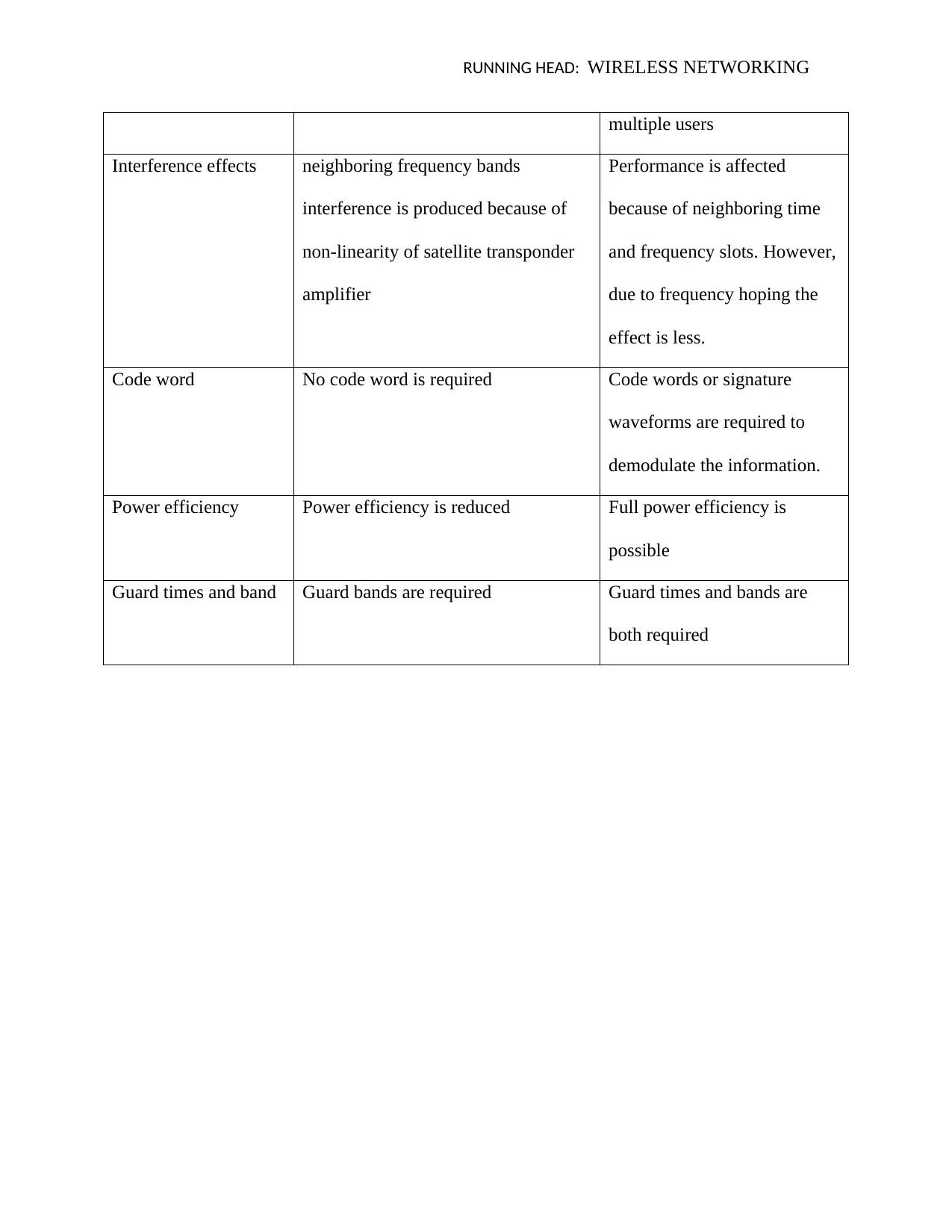
RUNNING HEAD: WIRELESS NETWORKING
multiple users
Interference effects neighboring frequency bands
interference is produced because of
non-linearity of satellite transponder
amplifier
Performance is affected
because of neighboring time
and frequency slots. However,
due to frequency hoping the
effect is less.
Code word No code word is required Code words or signature
waveforms are required to
demodulate the information.
Power efficiency Power efficiency is reduced Full power efficiency is
possible
Guard times and band Guard bands are required Guard times and bands are
both required
multiple users
Interference effects neighboring frequency bands
interference is produced because of
non-linearity of satellite transponder
amplifier
Performance is affected
because of neighboring time
and frequency slots. However,
due to frequency hoping the
effect is less.
Code word No code word is required Code words or signature
waveforms are required to
demodulate the information.
Power efficiency Power efficiency is reduced Full power efficiency is
possible
Guard times and band Guard bands are required Guard times and bands are
both required
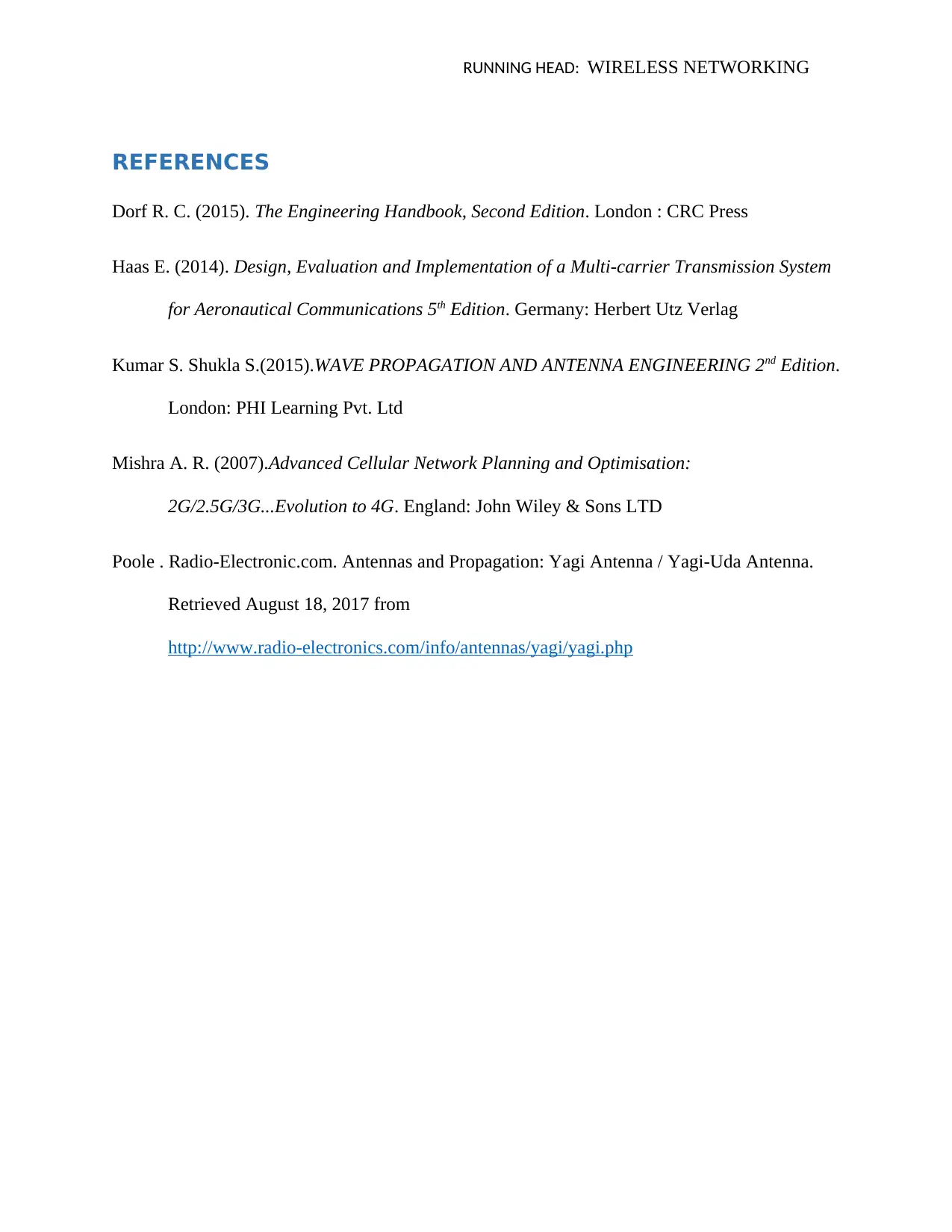
RUNNING HEAD: WIRELESS NETWORKING
REFERENCES
Dorf R. C. (2015). The Engineering Handbook, Second Edition. London : CRC Press
Haas E. (2014). Design, Evaluation and Implementation of a Multi-carrier Transmission System
for Aeronautical Communications 5th Edition. Germany: Herbert Utz Verlag
Kumar S. Shukla S.(2015).WAVE PROPAGATION AND ANTENNA ENGINEERING 2nd Edition.
London: PHI Learning Pvt. Ltd
Mishra A. R. (2007).Advanced Cellular Network Planning and Optimisation:
2G/2.5G/3G...Evolution to 4G. England: John Wiley & Sons LTD
Poole . Radio-Electronic.com. Antennas and Propagation: Yagi Antenna / Yagi-Uda Antenna.
Retrieved August 18, 2017 from
http://www.radio-electronics.com/info/antennas/yagi/yagi.php
REFERENCES
Dorf R. C. (2015). The Engineering Handbook, Second Edition. London : CRC Press
Haas E. (2014). Design, Evaluation and Implementation of a Multi-carrier Transmission System
for Aeronautical Communications 5th Edition. Germany: Herbert Utz Verlag
Kumar S. Shukla S.(2015).WAVE PROPAGATION AND ANTENNA ENGINEERING 2nd Edition.
London: PHI Learning Pvt. Ltd
Mishra A. R. (2007).Advanced Cellular Network Planning and Optimisation:
2G/2.5G/3G...Evolution to 4G. England: John Wiley & Sons LTD
Poole . Radio-Electronic.com. Antennas and Propagation: Yagi Antenna / Yagi-Uda Antenna.
Retrieved August 18, 2017 from
http://www.radio-electronics.com/info/antennas/yagi/yagi.php
⊘ This is a preview!⊘
Do you want full access?
Subscribe today to unlock all pages.

Trusted by 1+ million students worldwide
1 out of 6
Related Documents
Your All-in-One AI-Powered Toolkit for Academic Success.
+13062052269
info@desklib.com
Available 24*7 on WhatsApp / Email
![[object Object]](/_next/static/media/star-bottom.7253800d.svg)
Unlock your academic potential
Copyright © 2020–2025 A2Z Services. All Rights Reserved. Developed and managed by ZUCOL.





